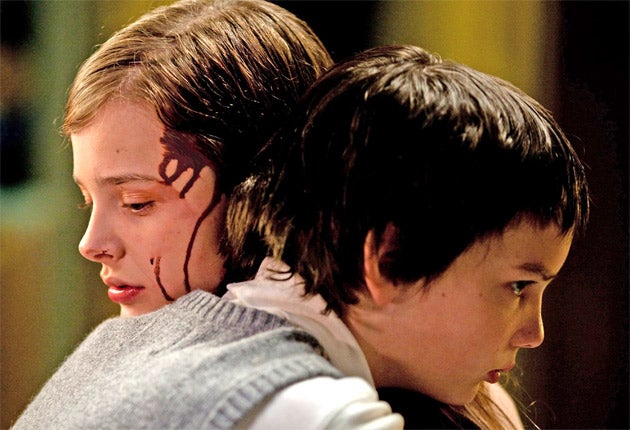Still haunted by the ghosts of the past
The return of Hammer sees the house of horror leave the Home Counties behind. Geoffrey Macnab welcomes new blood

Your support helps us to tell the story
From reproductive rights to climate change to Big Tech, The Independent is on the ground when the story is developing. Whether it's investigating the financials of Elon Musk's pro-Trump PAC or producing our latest documentary, 'The A Word', which shines a light on the American women fighting for reproductive rights, we know how important it is to parse out the facts from the messaging.
At such a critical moment in US history, we need reporters on the ground. Your donation allows us to keep sending journalists to speak to both sides of the story.
The Independent is trusted by Americans across the entire political spectrum. And unlike many other quality news outlets, we choose not to lock Americans out of our reporting and analysis with paywalls. We believe quality journalism should be available to everyone, paid for by those who can afford it.
Your support makes all the difference.Hammer horror is back in British cinemas with Let Me In.
The famous studio that brought us all those Christopher Lee and Peter Cushing movies has been resurrected. This is not, though, just an exercise in exhuming old storylines or finding actors who look a little like Lee. Let Me In is set in New Mexico, not Transylvania or the Home Counties and it's unthinkable that Hammer in its late 1950s prime would have made a film like it. As directed by Matt Reeves, it's as much about the psychological trauma of adolescence as it is a Grand Guignol horror picture. The early sequences play like something out of a Krzysztof Kieslowski film. The frenzied, stylised scenes of the vampires attacking are more in the spirit of F W Murnau's Nosferatu than they are of Hammer's Dracula pictures.
"Contrary to what people thought we would do, we haven't concentrated on the reimaginings or remakes of the back catalogue," says Hammer boss Simon Oakes. "We've focused in on the high-end thriller chiller area." Hammer's current slate includes a New York-set chiller called The Resident starring Hilary Swank and a big-screen version of Susan Hill's The Woman in Black starring Daniel Radcliffe. It's also struck a publishing deal with Random House for a series of horror books (including one by Jeanette Winterson).
Much has changed since Lee's younger days, when British horror films featured well-spoken middle-aged Englishmen in capes and tweed suits. There was something irredeemably kitsch about all those predatory female vampires in low-cut dresses. In recent years, there has been a determined attempt to domesticate Hammer, focusing on its pastoral English landscapes, cheery performances from much-loved character actors and vein of sanguinary humour. Hammer was seen as an integral part of British popular culture. That affection persists today. It's why the old films are so often revived, actresses like Ingrid Pitt are cult figures and a mini heritage industry has grown round Hammer's legacy, including a new book, The Art of Hammer: Posters from the Archive of Hammer Films by expert Marcus Hearn.
To be buried under layers of nostalgia is, though, disastrous for any self-respecting horror film. The real reason that Hammer movies were so popular wasn't because they were exercises in kitsch. Nor was it primarily to do with the décolletage of Hammer actresses. The success of the films lay in the fact that they were genuinely unsettling. I remember as a child being terrified by The Devil Rides Out (1968), with its famous coda in which the Duc de Richleau (Lee) and friends try to protect themselves inside a chalk circle as the forces of evil assail them throughout a very long night.
Like many of the best Hammer films, The Devil Rides Out was directed by Terence Fisher. What made him such a fascinating director was the brisk, commonsensical approach that he took to the most lurid and far-fetched material. His directorial style was perfectly complemented by Cushing, who never lost his no-nonsense demeanour. In his autobiography Tall, Dark and Gruesome, Lee relates an anecdote that sums up perfectly the self-deprecating professionalism of the Hammer company. When Lee first met Cushing on the set of The Curse of Frankenstein (in which Lee played the monster), he stormed into Cushing's dressing room and complained that he didn't have any lines. "Cushing looked up, his mouth twitched and he said dryly, 'You're lucky. I've read the script.'"
Watching Let Me In, you can't help but notice the Hammer logo on the opening credits. You register it but you're likely to forget it. That is surely all to the good. The film should be judged on its own merits and not looked at through the prism of all those Frankenstein and Dracula movies of yesteryear. The trick is reviving the old label without letting it suck the blood out of all the studio's new endeavours.
'Let Me In' is now on general release. 'The Art of Hammer' is published by Titan Books
Join our commenting forum
Join thought-provoking conversations, follow other Independent readers and see their replies
Comments